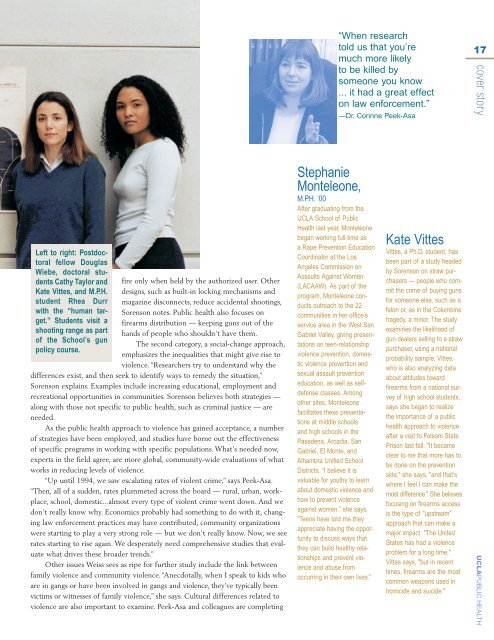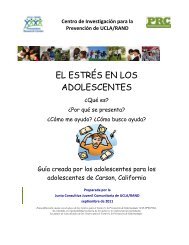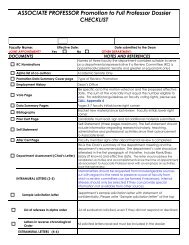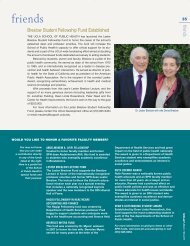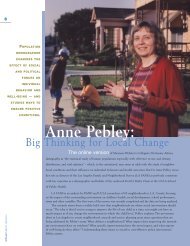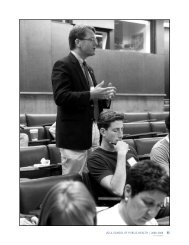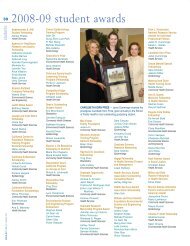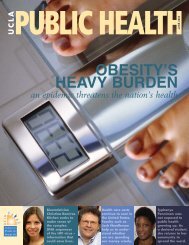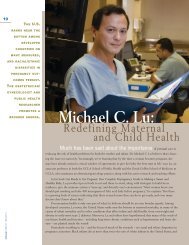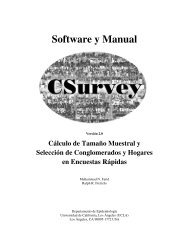JUNE 2001 - UCLA School of Public Health
JUNE 2001 - UCLA School of Public Health
JUNE 2001 - UCLA School of Public Health
You also want an ePaper? Increase the reach of your titles
YUMPU automatically turns print PDFs into web optimized ePapers that Google loves.
Left to right: Postdoctoral<br />
fellow Douglas<br />
Wiebe, doctoral students<br />
Cathy Taylor and<br />
Kate Vittes, and M.P.H.<br />
student Rhea Durr<br />
with the “human target.”<br />
Students visit a<br />
shooting range as part<br />
<strong>of</strong> the <strong>School</strong>’s gun<br />
policy course.<br />
fire only when held by the authorized user. Other<br />
designs, such as built-in locking mechanisms and<br />
magazine disconnects, reduce accidental shootings,<br />
Sorenson notes. <strong>Public</strong> health also focuses on<br />
firearms distribution — keeping guns out <strong>of</strong> the<br />
hands <strong>of</strong> people who shouldn’t have them.<br />
The second category, a social-change approach,<br />
emphasizes the inequalities that might give rise to<br />
violence. “Researchers try to understand why the<br />
differences exist, and then seek to identify ways to remedy the situation,”<br />
Sorenson explains. Examples include increasing educational, employment and<br />
recreational opportunities in communities. Sorenson believes both strategies —<br />
along with those not specific to public health, such as criminal justice — are<br />
needed.<br />
As the public health approach to violence has gained acceptance, a number<br />
<strong>of</strong> strategies have been employed, and studies have borne out the effectiveness<br />
<strong>of</strong> specific programs in working with specific populations. What’s needed now,<br />
experts in the field agree, are more global, community-wide evaluations <strong>of</strong> what<br />
works in reducing levels <strong>of</strong> violence.<br />
“Up until 1994, we saw escalating rates <strong>of</strong> violent crime,” says Peek-Asa.<br />
“Then, all <strong>of</strong> a sudden, rates plummeted across the board — rural, urban, workplace,<br />
school, domestic...almost every type <strong>of</strong> violent crime went down. And we<br />
don’t really know why. Economics probably had something to do with it, changing<br />
law enforcement practices may have contributed, community organizations<br />
were starting to play a very strong role — but we don’t really know. Now, we see<br />
rates starting to rise again. We desperately need comprehensive studies that evaluate<br />
what drives these broader trends.”<br />
Other issues Weiss sees as ripe for further study include the link between<br />
family violence and community violence. “Anecdotally, when I speak to kids who<br />
are in gangs or have been involved in gangs and violence, they’ve typically been<br />
victims or witnesses <strong>of</strong> family violence,” she says. Cultural differences related to<br />
violence are also important to examine. Peek-Asa and colleagues are completing<br />
Stephanie<br />
Monteleone,<br />
M.P.H. ’00<br />
After graduating from the<br />
<strong>UCLA</strong> <strong>School</strong> <strong>of</strong> <strong>Public</strong><br />
<strong>Health</strong> last year, Monteleone<br />
began working full-time as<br />
a Rape Prevention Education<br />
Coordinator at the Los<br />
Angeles Commission on<br />
Assaults Against Women<br />
(LACAAW). As part <strong>of</strong> the<br />
program, Monteleone conducts<br />
outreach to the 22<br />
communities in her <strong>of</strong>fice’s<br />
service area in the West San<br />
Gabriel Valley, giving presentations<br />
on teen-relationship<br />
violence prevention, domestic<br />
violence prevention and<br />
sexual assault prevention<br />
education, as well as selfdefense<br />
classes. Among<br />
other sites, Monteleone<br />
facilitates these presentations<br />
at middle schools<br />
and high schools in the<br />
Pasadena, Arcadia, San<br />
Gabriel, El Monte, and<br />
Alhambra Unified <strong>School</strong><br />
Districts. “I believe it is<br />
valuable for youths to learn<br />
about domestic violence and<br />
how to prevent violence<br />
against women,” she says.<br />
“Teens have told me they<br />
appreciate having the opportunity<br />
to discuss ways that<br />
they can build healthy relationships<br />
and prevent violence<br />
and abuse from<br />
occurring in their own lives.”<br />
“When research<br />
told us that you’re<br />
much more likely<br />
to be killed by<br />
someone you know<br />
... it had a great effect<br />
on law enforcement.”<br />
—Dr. Corinne Peek-Asa<br />
Kate Vittes<br />
Vittes, a Ph.D. student, has<br />
been part <strong>of</strong> a study headed<br />
by Sorenson on straw purchasers<br />
— people who commit<br />
the crime <strong>of</strong> buying guns<br />
for someone else, such as a<br />
felon or, as in the Columbine<br />
tragedy, a minor. The study<br />
examines the likelihood <strong>of</strong><br />
gun dealers selling to a straw<br />
purchaser, using a national<br />
probability sample. Vittes,<br />
who is also analyzing data<br />
about attitudes toward<br />
firearms from a national survey<br />
<strong>of</strong> high school students,<br />
says she began to realize<br />
the importance <strong>of</strong> a public<br />
health approach to violence<br />
after a visit to Folsom State<br />
Prison last fall. "It became<br />
clear to me that more has to<br />
be done on the prevention<br />
side," she says, "and that’s<br />
where I feel I can make the<br />
most difference." She believes<br />
focusing on firearms access<br />
is the type <strong>of</strong> "upstream"<br />
approach that can make a<br />
major impact. "The United<br />
States has had a violence<br />
problem for a long time,"<br />
Vittes says, "but in recent<br />
times, firearms are the most<br />
common weapons used in<br />
homicide and suicide."<br />
17<br />
cover story <strong>UCLA</strong>PUBLIC HEALTH


